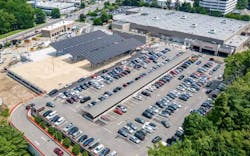Costco Tire Center Goes Off-Grid with Microgrid in Connecticut
Costco, a global membership warehouse retailer known for offering bulk products at discounted prices, has taken another step towards energy independence by adding a microgrid to its Norwalk, Connecticut, store.
The off-grid solar and battery storage system can deliver up to 2 MWh of electricity per day and will fully power the location’s standalone tire center.
The microgrid was installed by Trinity Energy, a Snohomish, Washington-based sustainable energy solutions provider of off-grid energy infrastructure.
"Energy should be treated as a necessary, finite resource as opposed to an expense or balance sheet charge,” said Shay Reed, assistant general merchandising manager at Costco Wholesale.
Costco has committed to operating with 100% clean energy sources by 2035, and it aims to reduce its Scope 1 and Scope 2 emissions by 39% by 2030, according to the company’s Climate Action Plan.
The retail giant has more than 800 stores worldwide.
“Our work with Trinity shows how energy can become a real asset that secures our operations, aligns with our sustainability goals, and reduces risk,” Reed added. “This partnership is helping us lead the way toward greater energy independence.”
Expanding Costco’s off-grid energy portfolio
Trinity previously installed an off-grid rooftop solar system at Costco’s 1-million square foot distribution center in Mira Loma, California. The power from that installation, which was completed in under four months, will be used to charge electric trucks.
“This isn’t just about providing clean energy, it’s about redefining energy as a strategic asset,” said Darin Leonard, president of Trinity Energy. “We’re enabling our partners to generate and manage their own energy with speed, autonomy, and ethical integrity.”
Going off-grid is a strategic choice
A growing number of corporations are adopting off-grid solutions, foregoing grid interconnections to avoid electricity price volatility and availability issues. This shift to reliance on on-site generation resources comes as the grid faces increasing stress from rising demand driven by data centers and electric vehicles.
In California, Carr Winery and Amond World, a refrigerated cold storage developer in the Central Valley, have both invested in off-grid microgrids to secure cheaper, cleaner and more reliable power.
Taylor Farms, a major North American fresh food producer also based in California, relies on an off-grid microgrid to supply electricity to a 450,000 square-foot facility in San Juan Bautista.
Trinity utilizes modular electrified structures and integrated microgrids to create ecosystems that include solar, battery storage, inverters and energy distribution systems.
“By integrating our advanced hardware and software into a single, cohesive solution, we guarantee customers an intelligent, proven, and rigorously tested renewable energy system designed to meet their current and future energy needs,” said Tim Owen, COO of Trinity Energy.
Direct Current Microgrids: DC Proponents Say It’s the One Direction to Go
About the Author
Kathy Hitchens
Special Projects Editor
I work as a writer and special projects editor for Microgrid Knowledge. I have over 30 years of writing experience, working with a variety of companies in the renewable energy, electric vehicle and utility sector, as well as those in the entertainment, education, and financial industries. I have a BFA in Media Arts from the University of Arizona and a MBA from the University of Denver.

